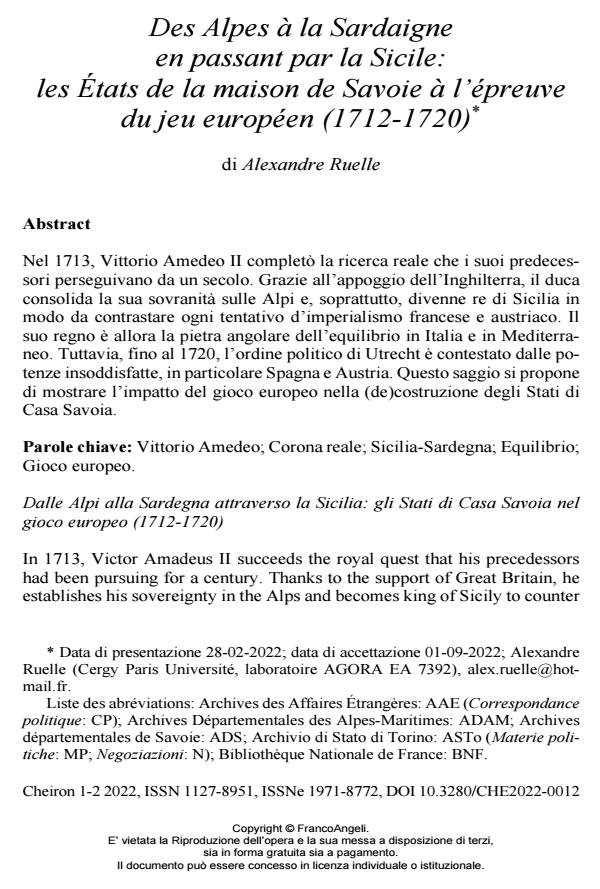Des Alpes à la Sardaigne en passant par la Sicile: les États de la maison de Savoie à l’épreuve du jeu européen (1712-1720)*
Journal title CHEIRON
Author/s Alexandre Ruelle
Publishing Year 2023 Issue 2022/1-2
Language French Pages 21 P. 206-226 File size 371 KB
DOI 10.3280/CHE2022-001012
DOI is like a bar code for intellectual property: to have more infomation
click here
Below, you can see the article first page
If you want to buy this article in PDF format, you can do it, following the instructions to buy download credits

FrancoAngeli is member of Publishers International Linking Association, Inc (PILA), a not-for-profit association which run the CrossRef service enabling links to and from online scholarly content.
In 1713, Victor Amadeus II succeeds the royal quest that his precedes-sors had been pursuing for a century. Thanks to the support of Great Britain, he establishes his sovereignty in the Alps and becomes king of Sicily to counter any attempt at French and Austrian imperialism. His kingdom is at the center of the balance in Italy and Mediterranean. However, until 1720, the order of Utrecht is contested by the discon-tented powers, mainly Spain and Austria. This article proposes to show the impact of the European game in the (de)construction of the States of the House of Savoy.
Nel 1713, Vittorio Amedeo II completò la ricerca reale che i suoi pre-decessori perseguivano da un secolo. Grazie all’appoggio dell’Inghilterra, il duca consolida la sua sovranità sulle Alpi e, soprat-tutto, divenne re di Sicilia in modo da contrastare ogni tentativo d’imperialismo francese e austriaco. Il suo regno è allora la pietra an-golare dell’equilibrio in Italia e in Mediterraneo. Tuttavia, fino al 1720, l’ordine politico di Utrecht è contestato dalle potenze insoddisfatte, in particolare Spagna e Austria. Questo saggio si propone di mostrare l’impatto del gioco europeo nella (de)costruzione degli Stati di Casa Savoia.
Keywords: Vittorio Amedeo, Royal Crown, Sicily-Sardinia, Balance, European Game.
Alexandre Ruelle, Des Alpes à la Sardaigne en passant par la Sicile: les États de la maison de Savoie à l’épreuve du jeu européen (1712-1720)* in "CHEIRON" 1-2/2022, pp 206-226, DOI: 10.3280/CHE2022-001012